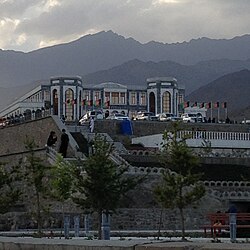List
| Castle | Location | Type | Constructed/ earliest mention | Notes | Image |
|---|---|---|---|---|---|
| Arg | Kabul | Presidential palace | 1880 | The Arg means 'citadel' in Pashto. The Arg was built after the destruction of the Bala Hissar in 1880 by the British Indian troops. |  |
| Bagh-e Bala Palace | Kabul | Palace | 1893 | Former royal palace built by Emir Abdur Rahman Khan. |  |
| Bala Hissar | Kabul | Fort | 5th century | The estimated date of construction is around the 5th century AD. [1] |  |
| Chihil Sutun | Kabul | Palace | 1888 | Historic maps also refer to the palace as Hendaki. [2] |  |
| Citadel of Ghazni | Ghazni | Citadel | 13th century | It was built in the 13th century surrounding Ghazni to form a walled city. [3] |  |
| Darul Aman Palace | Kabul | Palace | 1927 | In 2019, the palace was fully renovated for the 100th year of Afghan Independence, which was on the 19th of August, 2019. [4] [5] |  |
| Farah Citadel | Farah | Citadel | Also known as the Citadel of Alexander, and locally known as Shar-e-Farahdun. Some claim it was built by Alexander the Great. Others say the citadel is to have been built by Zoroastrian warriors in the time of Darius the Great (reigned 522-486 BC). Some renovations built atop the ancient foundation may add to the confusion regarding the age of the Citadel. [6] |  | |
| Herat Citadel | Herat | Citadel | 330 BC | Also known as the Citadel of Alexander, and locally known as Qala Iktyaruddin. Many empires have used it as a headquarters in the last 2,000 years, and was destroyed and rebuilt many times over the centuries. |  |
| Lashkari Bazar | Bost | Palace | | ||
| Paghman Hill Castle | Paghman | Palace | 2014 | It was planned to be used for major festivals. [7] The castle and surrounding areas are used as a presidential retreat and a location to host foreign guests. [8] |  |
| Palace of Sultan Mas'ud III | Ghazni | Palace | 1112 | Ghaznavid palace. | |
| Qala-e-Bost | Bost | Fort |  | ||
| Qala-e-Seraj | Mihtarlam | Palace | 1912–13 | Built by Amir Habibullah Khan. | |
| Qala-i-Jangi | Mazar-i-Sharif | Fort | 1889 | The Afghans built the fort in 1889 for defense against potentially invading British after the Second Anglo-Afghan War. It took 18,000 workers 12 years to complete it. [9] |  |
| Qalat-e Gilzay | Qalati Ghilji | Fort | 4th century BC | The fortress constructed by the forces of Alexander the Great. [10] | |
| Tajbeg Palace | Kabul | Palace | 1795 | Inaccurately called the Queen's Palace. According to some historians, the palace seems to have been renovated by Zaman Shah Durrani in 1795 (1210 AH), which was subsequently destroyed in military conflicts, and the ruins from ancient times remain. [11] |  |
| Ibrahim Khan Sanjrani Fort | Chakhansur District | Fort | 13th/19th century | The seat of a local Sanjrani Chiefdom at the beginning of the 13th/19th century. [12] |  |

